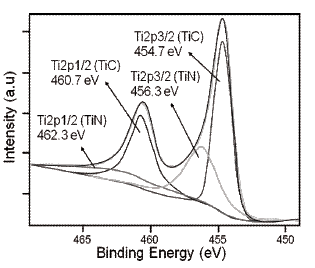

Re 2O 7 provided very low friction coefficient to (Ti,Re)N. I cannot understate how much of a generational leap this will be for the XPS 15. The oxide layer formed on (Ti,Re)N were the mixture of TiO 2, Ti O N, ReO 2 and Re 2O 7 for both test temperatures. For TiN, main oxide component of the tribolayers was Ti 2O 3 for RT tests and TiO 2 for HT tests. Typical portions of the XPS spectra corresponding to Ti 2p and N15 and recorded for the. This satellite peak what represent the valence state of titanium like Ti 3+ 0r Ti 4+ can. The formation of TiN was definitely identified from the XPS spectra. Rhenium addition also improved the wear resistance of the coating at both test temperatures. The SrTiO3 ceramics, the XPS spectra of Ti 2p gave satellite peak the binding energy value at 460.2eV. Rhenium addition to TiN drastically dropped the friction coefficients to 0.22 and 0.17 for RT and HT samples. Friction coefficients of TiN were 0.56, 0.35 for 21 ☌ and 150 ☌ tests, respectively. The first peak at binding energy of 401.2 eV was assigned to the presence of oxidized nitrogen such as TiON (Han and Bai, 2009), while the latter peak was attributed to anionic N in the form of NTiO bond (Xu et al., 2008).

The experimental details are given in Ref. 4B, two N1s XPS peaks were presented at 401.2 and 399.6 eV, respectively. The peak position of metallic tin, Sn0, is located at 484.8 eV, while the peaks. The dots are experimental data and the solid curves are from Gaussian fitting. There are two kinds of chemical states of tin: tin oxides and metallic tin. A shoulder, labeled as Ti 3 +, at about 1.5 eV below the main Ti 4 + peak appears for all n-doped samples. The tribolayers were analyzed by XPS technique. Experimental Ti 2 p XPS spectra for stoichiometric, 15 La-doped, 10 Nb-doped, and oxygen-deficient SrTiO 3. Tribological behaviors of the samples were tested against Al 2O 3 balls at 21 ☌ (RT) and 150 ☌ (HT) by reciprocating wear technique. High Resolution Scan - C1s Region - HOPG Edge Planes C-C sp2 C-C sp3 Carboxylic Phenols Carbonyl Graphitic Defects. The hardness of TiN and (Ti,Re)N were 31 GPa and 29 GPa ( ± 2 GPa), respectively. Average XPS peaks 10000 Diesel Soot Plant OFB 8000 Wildfire Jet engines 6000 Industrial OFB Residential OFF Biodiesel A 4000 Biodiesel B 2000 0 Peak positions. The (Ti,Re)N coating consisted of TiN and ReN x ( x > 1.33) phases. In order to keep rhenium content low (8 ± 1.9 at.%) in the coating, magnetron sputtering technique was utilized to evaporate rhenium. TiN and (Ti,Re)N coatings were deposited on high-speed-steel substrates by a hybrid coating system composed of cathodic arc PVD and magnetron sputtering techniques.


 0 kommentar(er)
0 kommentar(er)
